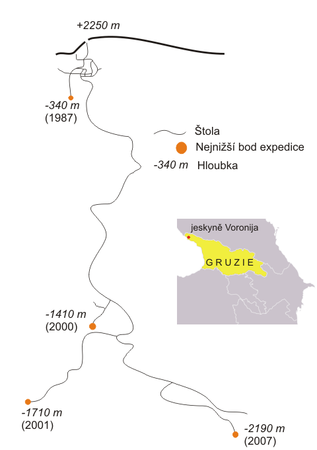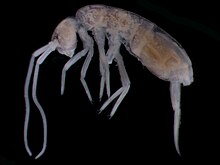Voronja Cave
| Voronja Cave
|
||
|---|---|---|
|
Vertical section and location of the cave |
||
| Location: | Abkhazia , Georgia | |
| Height : | 2250 m | |
|
Geographic location: |
43 ° 24 '35 " N , 40 ° 21' 44" E | |
|
|
||
| Geology: | limestone | |
| Type: | active water cave, high alpine cave | |
| Discovery: | 1960 by Georgian geologists | |
| Overall length: | 16.058 km | |
| Level difference: | 2197 m | |
| Particularities: | second deepest cave in the world | |
The Voronja Cave (also Krubera Cave ; Georgian კრუბერის გამოქვაბული ) is a cave in Abkhazia , Georgia . The limestone cave is located in the Arabika massif in the western Caucasus ; the nearest town is Zandrypsch on the Black Sea coast. With a measured 2197 meters it is the second deepest known cave in the world.
location
The cave is located in the Arabika massif, a mighty limestone slab made of limestone from the Jura and chalk , which is bordered by the deeply carved canyons of the Sandripschi , Kuturuscha , Gega and Bsipi rivers. The Black Sea connects to the south, with the limestone formation continuing below the sea surface. In the central part, the massif has a high mountain character and lies above the tree line , which in the region is at an altitude of around 1800 to 1900 meters; the highest peaks of the Gagra ridge , the Arabika summit and the " peak of speleologists " ( Peak of Speleologists ) reach heights of 2695 and 2705 meters. The high plateau, divided by low chains and high valleys, is mostly at an altitude of 2000 to 2350 meters. The cave entrance is located in the shallowly incised Ortobalagan Valley, a glacial channel, at an altitude of 2256 meters above sea level. It is a typical glaziokarst region with several hundred known caves, five of which are more than 1000 meters deep.
description
The cave begins with a vertical shaft about one meter wide and four meters long, 60 meters deep; it is extremely steep throughout and consists mainly of a sequence of vertical shafts connected by narrow, winding passages. At greater depths, shallower passages following the rock stratification, which are much older than the rest of the cave. Numerous crows nest in the entrance shaft , from which one of the names of the cave is derived ("Voronja", from Russian ворон , woron ). At a depth of around 95 meters there is a narrow point that prevented exploration of the deeper sections of the cave for decades. The unsaturated ( vadose ) zone with air-filled cavities , which extends to extreme depths, is unusual . Within the limestone slab, water-saturated horizons are switched on at different depths, in which rapidly flowing waters drain directly into the Black Sea via the system of fissures and caves, sometimes at a depth of up to 400 meters. The cave branches into two separate shafts at a depth of about 300 meters, the second also reaches a depth of 1,697 meters.
The cave is mostly air-filled for most of the year with minimal water flow in winter and maximum during the snowmelt between late May and July. During this time, some shafts and numerous passages below 1000 meters are filled with water ( called siphons by speleologists ). A permanent cave river exists from a depth of 340 meters, but not accessible everywhere, its water flow does not increase to the final depth. The water and air temperature reaches a minimum of 1.0 ° C and rises down to 7.2 ° C at a depth of 2000 meters; as is typical for caves, it is more or less constant all year round. As is typical for Glaziokarst, the temperature for the respective depth is unusually low due to falling cold air masses.
The deepest reachable point in the cave system at 2197 meters is only 60 meters higher than the water level of the Black Sea. The entire karst system, of which the cave is a part, reaches a total height of 2700 meters from the highest heights to the deepest submarine freshwater outlet.
Chronology of Exploration
The cave was discovered by Georgian geologists in 1960. It was named after Alexander Kruber (1871–1941), one of the pioneers of Russian karst research. The systematic research began in 1980 by the Kiev Speleological Club with Alexander Klimchuk. In 1987, a depth of 340 meters was reached, then the exploration had to be interrupted until 1999 due to political instability (Abkhazia split off by armed separatists, war from 1992 to 1994). In January 2001 the cave explorers reached a depth of 1710 meters. For the first time in the history of cave exploration, the Voronja Cave was considered to be the deepest in the world outside of Western Europe. A Cave Exploration Team (CAVEX) led by Alexander Klimchouk first descended 2040 meters in July 2005 and then down to 2164 meters in October 2005. An expedition ended in September 2007 enlarged the explored part of the cave to a depth of 2191 meters. This means that only about 60 meters vertically remain to the surface of the Black Sea, 13 km away. International teams continue to explore the cave.
Cave fauna
The cave has a rich fauna of specialized invertebrate species (the technical term is troglobionte ), both air-breathing and water-living (aquatic) species of the cave waters (colonists of the karst groundwater, Stygobionta ). Settlers were encountered at depths of more than 2000 meters. A total of 16 species were found in the cave, 8 of them stygobionte with morphological adaptations such as elongated limbs or regression of the eyes and pigmentation. In the siphon in 2140 feet of water were still alive freshwater shrimp of the genera Troglocaris and Zenkevitchia which Springtail Plutomurus ortobalaganensis came down to 1980 meters depth before. The winged winter mosquito Trichocera maculipennis was found in all depths. The top predator in the cave is the troglobionte pseudoscorpion Neobisium birsteini . Another notable species, the nest beetle Catops cavicis , reaches 600 meters. A ground beetle species - Duvalius abyssimus - was first described from the cave and has not yet been found anywhere else.
literature
- Alexandre Klimchouk, Youri Kasjan: A la recherche du moins 2000. Le gouffre Krubera (Voronya). In: Spelunca. Volume 82, Paris 2001, pp. 15-24.
Web links
- Report on the exploration of the Voronja Cave up to 2164 meters (English)
- Profile view of the Voronja cave (status 2004, no longer current)
- Map of the Voronja Cave (2004)
- Photo series from the Voronja Cave (English)
Individual evidence
- ↑ a b Bob Gulden: Worlds deepest caves. In: GEO2 Committee on long and deep caves. National Speleological Society , April 22, 2011, accessed June 21, 2011 .
- ↑ a b Alexander B. Klimchouk: Kubera (Voronja) Cave. In: William B. White, David C. Culver: Encyclopedia of Caves. 2nd Edition. Elsevier, 2012, ISBN 978-0-12-383832-2 .
- ↑ AB Klimchouk, GV Samokhin, YM Kasian: The deepest cave in the world in the Arabika Massif (Western Caucasus) and its hydrogeological and paleogeographic significance. Proceedings of the 15th International Congress of Speleology. 2009, pp. 898-905.
- ↑ Alexander Klimchouk: New world depth record in the Arabika massif (West Caucasus) . In: Association of Austrian cave researchers and association of German cave and karst researchers eV (ed.): Die Höhle - magazine for karst and cave science . tape 52 , no. 1 . Vienna 2001, p. 15–16 ( 471 KB PDF [accessed October 5, 2012]).
- ↑ Stephen Macnamara, Tony Furnell: Krubera-Voronja Cave. International Expedition August 2009. unpublished. Report for the Speleological Union of Ireland, 2012. PDF
- ^ Alberto Sendra, Ana Sofia PS Reboleira: The world's deepest subterranean community - Krubera-Voronja Cave (Western Caucasus). In: International Journal of Speleology. 41 (2), 2012, pp. 221-230.
- ↑ Pier Mauro Giachino: Catops cavicis n. Sp. from Krubera Cave (Abkhazia, Caucasus), an interesting species of the C. alpinus group (sensu Perrau, 2000) (Coleoptera, Cholevidae). In: Boletín de la Sociedad Entomológica Aragonesa. 39, 2011, pp. 87-89.
- ↑ Ana Sofia PS Rebleira, Vicente M. Ortuno: A new species of Duvalius from world's deepest cave (Coleoptera: Carabidae). In: Zootaxa. 3784 (3), 2014, pp. 267-274.



